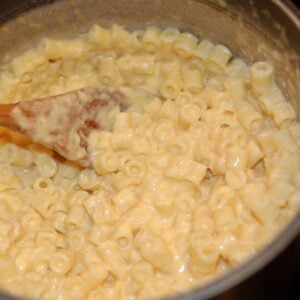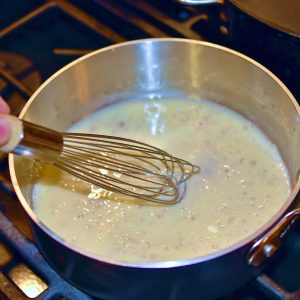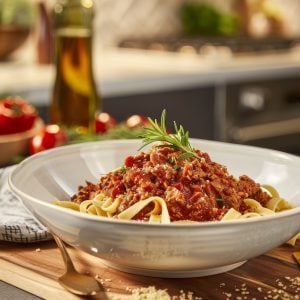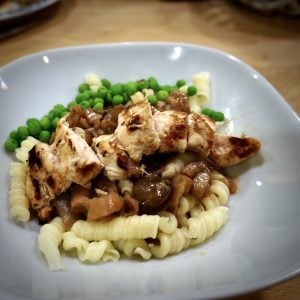How to Make Restaurant Quality Hollandaise Sauce
Hollandaise sauce, a hallmark of classic French cuisine, is a silky, buttery, tangy delight that has graced breakfast tables and elegant dinners for centuries. This rich and velvety sauce, made from a delicate emulsion of egg yolks, butter, and lemon juice, is renowned for its luscious texture and bright flavor.
Whether draped over a perfectly poached egg in Eggs Benedict, adorning tender asparagus spears, or enhancing a succulent piece of fish, Hollandaise sauce elevates any dish it accompanies. Join me as I delve into this exquisite sauce’s history, technique, and versatility, and discover tips and tricks to mastering its preparation in your kitchen.
Hollandaise Sauce
Hollandaise sauce, one of the five mother sauces in French cuisine, is celebrated for its luxurious texture and rich, tangy flavor. This classic sauce, named after Holland, is fundamental in dishes such as Eggs Benedict, grilled asparagus, and poached fish. Its creation involves a precise emulsion of egg yolks, clarified butter, and lemon juice or vinegar, producing a smooth and creamy consistency that enhances various dishes.
The origins of Hollandaise sauce can be traced back to the 17th century. Still, it gained prominence in French culinary tradition during the 19th century, thanks to the influential chef Marie-Antoine Carême. Its seemingly simple preparation requires careful attention to temperature and technique to avoid curdling or separating. The egg yolks are gently whisked over a double boiler until they thicken, and then warm, clarified butter is slowly incorporated, followed by an acid component to balance the richness.
Mastering Hollandaise sauce is a testament to a cook’s skill and patience. Its versatility allows it to complement a range of dishes, from vegetables and seafood to steak. The sauce adds a burst of flavor and a touch of elegance, making it a favorite in both home kitchens and fine dining establishments.
History of Hollandaise Sauce
Hollandaise sauce, with its rich, buttery flavor and tangy undertones, pairs beautifully with various dishes, elevating their taste and presentation. Here are some classic and popular pairings:
- Eggs Benedict: Perhaps the most iconic pairing, Hollandaise sauce is a crucial component of Eggs Benedict. It is drizzled over poached eggs, Canadian bacon or ham, and a toasted English muffin.
- Asparagus: Steamed or grilled asparagus spears gain a luxurious touch when served with a generous dollop of Hollandaise sauce.
- Fish: Delicate fish such as salmon, sole, or trout benefit from Hollandaise’s rich, creamy texture. It complements the mild flavors of the fish without overpowering them.
- Vegetables: In addition to asparagus, green vegetables like broccoli, green beans, and Brussels sprouts are elevated with Hollandaise, adding a decadent touch to healthy sides.
- Steak and Beef: A lightly drizzled Hollandaise can enhance a juicy steak or beef tenderloin, providing a sophisticated alternative to traditional sauces.
- Crab Cakes: The sauce adds a creamy contrast to crab cakes’ crispy exterior and savory interior, making for a delightful combination.
- Egg Dishes: Beyond Eggs Benedict, Hollandaise pairs well with various egg dishes, including omelets, frittatas, and quiches, adding richness and depth.
- Potatoes: Whether over roasted potatoes, hash browns, or a potato gratin, Hollandaise sauce brings a smooth, velvety finish that complements the earthy flavors of potatoes.
- Poultry: Roasted or grilled chicken and turkey can be enhanced with a touch of Hollandaise, adding a layer of richness to leaner meats.
- Shellfish: Lobster, shrimp, and scallops pair wonderfully with Hollandaise, as the sauce accentuates the natural sweetness and tenderness of the seafood.
These pairings showcase the versatility of Hollandaise sauce, making it a staple in classic and contemporary cuisine.
Hollandaise Sauce
Ingredients
- 7 ounces salted butter If you have unsalted butter you can add a ¼ teaspoon salt to the sauce.
- 2 egg yolks
- 2 tablespoons lemon juice
- ½ teaspoon lemon zest finely grated
- 2 tablespoons white wine vinegar
Instructions
Technique for Hollandaise
- First, we need to melt the butter. This needs to be done five minutes or so before the milk solids can sink to the bottom. This is important when we whisk in the butter, as it allows us to control the consistency of the sauce.
- Place a large pot filled to a third with water on to boil. Choose a stainless steel mixing bowl that sits on top of the pot but does not touch the water, and place the egg yolks, lemon juice, zest, and vinegar into the mixing bowl.
- Turn the heat down to just under a simmer; this is the ideal heat and won't cook the yolks too fast.
- Set the bowl over the water and gently whisk the yolk mixture over the water; they will slowly start to heat and increase in volume. Remember, the purpose of the whisking is not to aerate the mixture so much as to avoid the yolks catching and ensuring even thickening.
- The yolk mixture becomes thicker on the bottom and around the edges. Keep a towel around the outside of the bowl to remove it from the heat if it starts to form lumps from heating too fast.
- Keep the yolk mixture moving constantly by whisking continuously. You will notice the bubbles that form will get smaller and smaller and soon become the more significant part of the yolk mix as the runny yolk cooks.
- The only thing necessary to remember at this stage is to lift the bowl above the pot to slow down the heating if it starts to catch.
- The yolk mixture should hold its shape like a soft whipped cream for around five to ten minutes, and the texture should be smooth. This means the yolks are cooked but not to the point of being scrambled, and you have made yourself a " sabayon " in French cooking."
- Next comes whisking in the butter; make sure the butter is hot. Place the sabayon bowl onto a damp cloth so it won't spin while you whisk.
- While whisking fast, slowly pour on the butter, keeping a steady stream of butter but keeping the stream as thin as possible.
- Don't add more butter than you can whisk in; if the sabayon is overloaded, it will split the mixture (be patient, especially if you are a beginner).
- At first, the whisking is relatively easy, but as the butter is slowly incorporated, it becomes more challenging. Add the butter slower at this stage to compensate.
- As you near the milk solids, be at your most diligent not to add too much as the hollandaise is more likely to split at this stage, then slowly pour in the milk solids while still whisking; this will loosen the hollandaise and set the consistency.
- Usually, adding all the milk solids is the correct amount of moisture that the hollandaise needs, but it can be too much, so add slowly in case you don't want the hollandaise to be that thin.
- Alternatively, if you have added all the milk solids and it is still thicker than you would like, add a little boiling water to compensate.
- Variation can occur due to the size of the eggs. Check the seasoning, transfer to a small stainless steel bowl, and cover with cling film.
- Keep in a warm place until serving time. You can safely make the hollandaise for up to two hours before you need it.
- If the butter has been added too fast and has split slightly, you can use a blender to blitz the emulsion and save it. Please remember to keep the sauce warm; if it cools too much, the butter will start to set, and you guessed it, "split," the most dreaded of all kitchen terms to a chef.
Different Flavors for Hollandaise
Lime Hollandaise
- Exchange the lemon zest and juice for lime zest and juice in the basic recipe. Like lemon hollandaise, I served with any seafood or freshwater fish and crustacean.
Basil Hollandaise
- Add chopped basil to the finished hollandaise, perfect in spring with new season asparagus and a great vegetable sauce.
Béarnaise Sauce
- Exchange the lemon juice for strong tarragon vinegar and omit the lemon zest. Add chopped fresh tarragon, chervil, and parsley at the end and season well with freshly milled black pepper.
- If you don't have all those herbs, use one, preferably tarragon. The best red meat sauce ever!
Notes
Some of My Favorite Sauce Recipes

















One Response
Knorr Hollandaise sauce mix was the worse mix I have ever tried.My husband even asked what kind of stuff did you say this was?He knows Hollandise. I even wonder if the wrong mix was in the packet labeled Hollandaise.I threw it out.Yuckie,stick to soup.